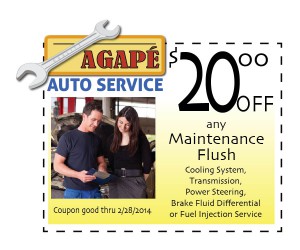 What is a Cooling System Service?
What is a Cooling System Service?
Whenever a fluid is in contact with metal, electrochemical degradation takes place which results in a higher than normal level of acid present in any give fluid. This higher acid level, if left unchanged, can result in very costly repairs. As a result, it is recommended to flush your cooling system, and most importantly pH balance your antifreeze at least once every 2 years or 30,000 miles. This will help reduce the acid level and extend the life of your radiator, heater core, water pump, head gaskets, freeze plugs, radiator and heater hoses.
Why is it important to have your cooling system flushed by a knowledgeable repair shop with all the right equipment? Why you can’t do it yourself? You have probably heard many times that your cooling system should be good to –35 degrees and you wonder why, when it gets that cold. The reason is: water is the best conductor of heat because the molecules are spaced far apart and heat can move into the water very easily. The problem with water is, it’s corrosive when in contact with metal and can freeze. Ethylene glycol silicone based antifreeze is added to the water to protect the metal, keep the water from freezing and lubricate the only moving parts in the cooling system such as the water pump and thermostat.
If you use 100% antifreeze, the engine may overheat in hot weather with or without you air conditioning on. The reason is antifreeze molecules are packed tightly together and are unable to remove the heat from the engine as efficiently as water. The condenser for your car’s air conditioning operates much hotter than the radiator; that’s why it is placed in front of the radiator. The radiator dissipates the heat from your air conditioning condenser and this makes the coolant even hotter!
With today’s new computer controlled engines, the coolant temperature is most important! The temperature sensor tells the computer, along with other sensors, how to adjust the fuel mixture and ignition timing. This may affect engine performance and efficiency.
For the best heat removal and metal protection 50% water and 50% antifreeze is desired. The proper mix is determined by checking the coolant level; -35 degrees equals 50/50. The problem comes when the pH of water is 7.0 to 7.2 and antifreeze pH is 10.5 right out of the gallon. A 50/50 mix of water and antifreeze would have a pH factor of 8.75. This level is too acidic for today’s cooling systems.
The recommended pH level should be between 9.8 and 10.5; this level greatly reduces the acid content that together with electrochemical reaction of dissimilar materials causes electrochemical degradation.
To correct the above condition, you need to power flush your cooling system by continuously forcing the coolant under pressure through the engine, radiator and heater core. A cleaning agent is added to help with the flush process.
Once the system has been thoroughly flushed, the system is refilled with premixed antifreeze and conditioners at a PH of 10.5, starting at 10.5 is important because overtime the PH degrades to a lower number.
The coolant should stay within the safe range of 9.8 to 10.5 pH level about 2 years or 30,000 miles. We also pressure test the system for leaks, clean the recovery bottle and test the radiator cap to see if it holds the proper pressure.
Check your vehicle service guide for service intervals
CarGuy Agapé Auto Service – “Your Trusted Dealership Alternative” ASE Certified Master Technicians
